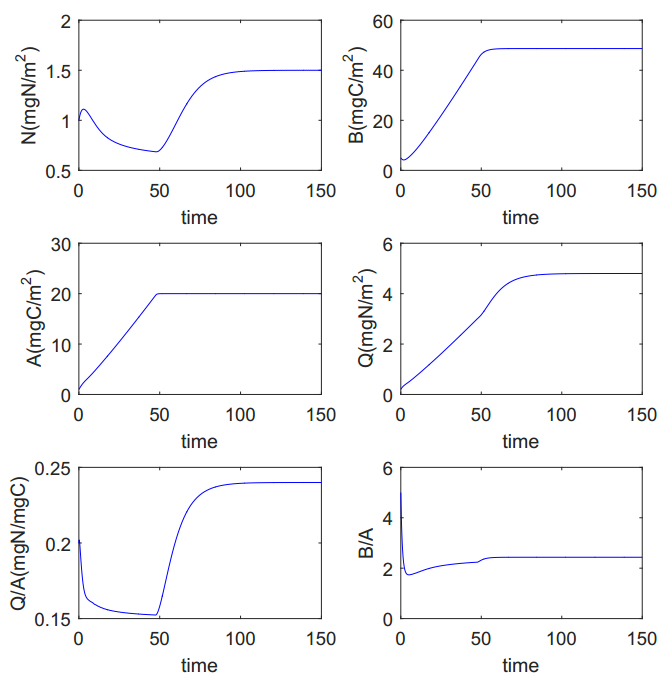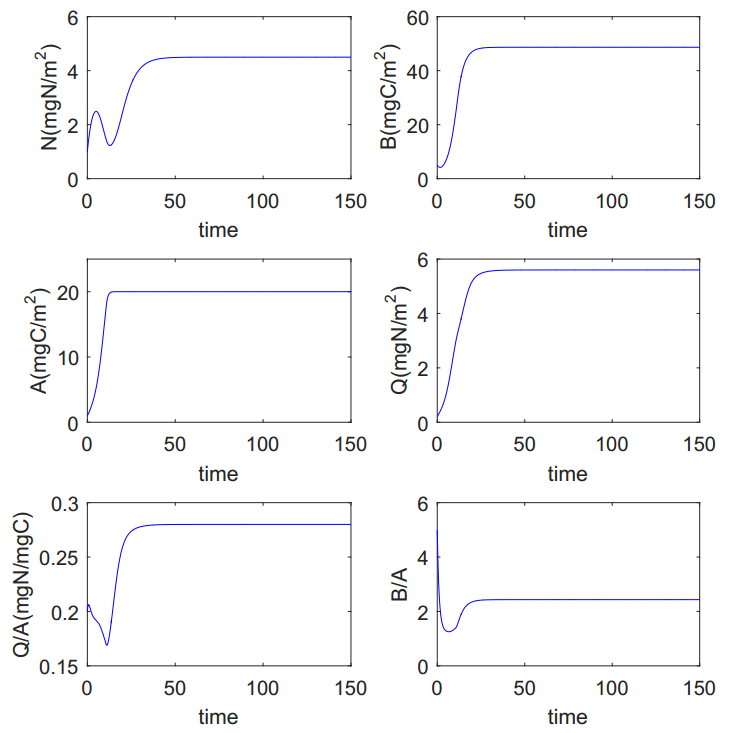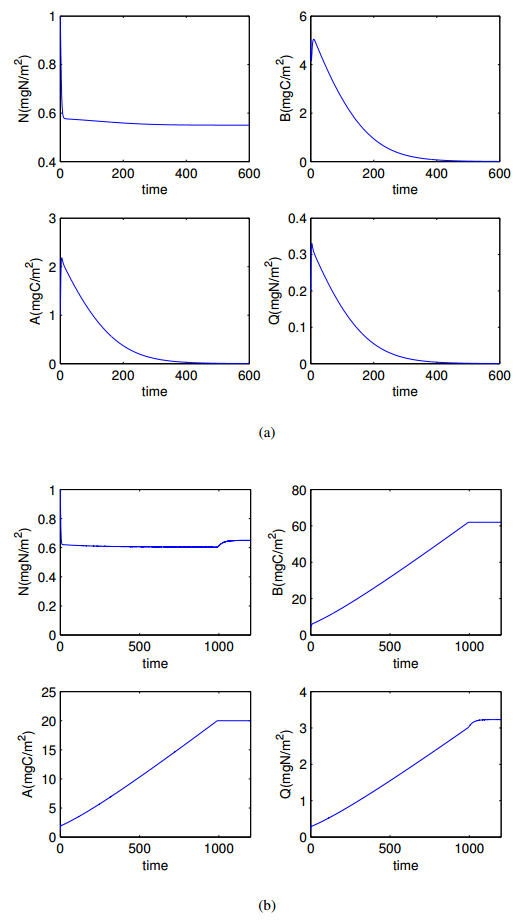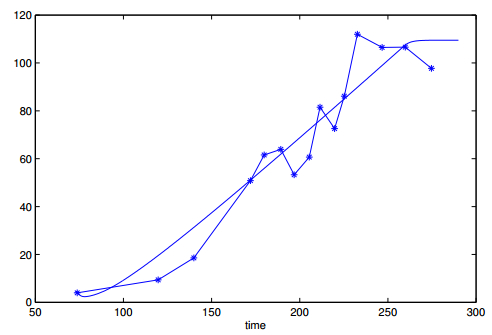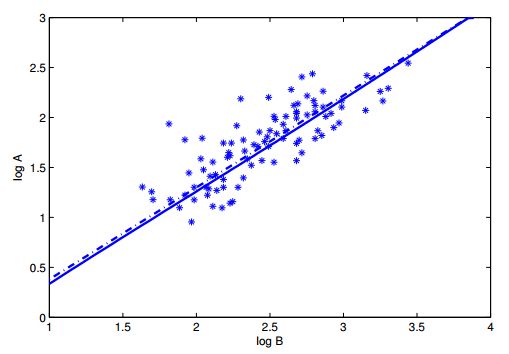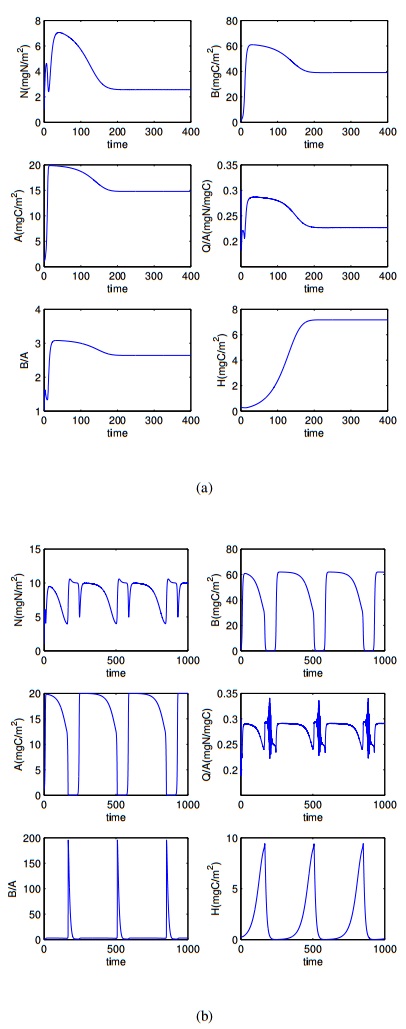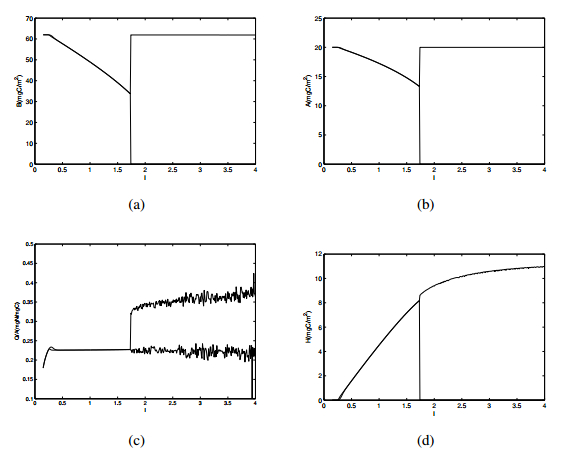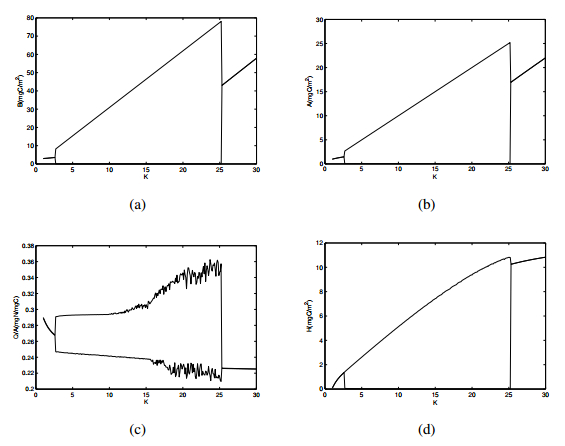Grassland ecosystems are the most widely distributed terrestrial ecosystems of the world. Many studies focus on aboveground grassland, but the belowground grassland is less explored because of the difficulty of sampling. Furthermore, the above-and-below ground biomass allocation mechanism of herbs is still disputed between the isometric growth hypothesis and the optimal partitioning hypothesis. In this study, a regrowth dynamic model, based on nutrient dynamics and stoichiometry, is proposed and analyzed to investigate the interaction between the aboveground and belowground herbaceous plants. The global dynamics of the belowground and aboveground biomass is well analyzed. Numerical simulations conclude that the herbaceous plant's biomass allocation mechanism for the aboveground and the belowground is in conformity with optimal partitioning at the beginning of growth, when the environment changes, it conforms to the constraints of isometric growth. Moreover, the dynamics of the model agree well with experimental data, which reveals that the model can express the relationship between aboveground and belowground biomass. Finally, a regrowth-herbivore model is established to explore the e ects of nutrition and light intensity on the dynamics of plant and herbivore biomass.
1.
Introduction
A grassland ecosystem is the collection of plants, animals and micro-organisms that live within an environment where grasses are the primary form of vegetation. Grassland is the most widely distributed type of vegetation, accounting for about one fifth of the world's land area, and so an important part of terrestrial ecosystem [1].
Grassland has significant impact on global climate change and on the estimation of the carbon reserve. Nowadays, there is more research on aboveground grassland vegetation than on that of belowground because of difficulties in sampling and of limited measurement methods. Moreover, Mokany et al. [2] found that 62% of 786 observations on terrestrial biomes are unreliable, resulting in inadequate or unverifiable root sampling methods. Therefore, to obtain measures of the carbon reserve more easily and accurately, researchers often use the ratio of above-and-belowground biomass allocation (i.e. root:shoot ratio) to estimate the belowground biomass [3].
There are many studies about aboveground and belowground biomass allocation. However, those studies give different ratios of aboveground to belowground biomass due to variation in study environment, methods, and target species. At present, the work on aboveground and belowground biomass allocation mainly focuses on isometric allocation hypotheses and optimal partitioning hypotheses. The isometric allocation hypothesis predict that the aboveground and belowground biomass scales will not change with varying environment conditions, which means that its growth is isometric [4,5,6,7,8,9]. The optimal partitioning hypothesis suggests that the environment conditions that restrict plant growth allocate more plant biomass to the organs restricted by the environment to capture more nutrients [10,11], water [12,13], and light [14] to maximize their growth rate. In fact, almost all the conclusions about the above-and-below ground relationship are made by direct measurement or using regression analysis to predict the ecological environment [15]. There is no doubt that these results made a great contribution to grassland ecology, but they still have some limitations. When the objective of the experimental conditions changes, the conclusions will be invalid, especially because the work does not show the similarity of plant growth. If we can establish a model of the mechanism of plant growth, the results obtained by the model will overcome these limitations. This can help us reduce the workload and have a deeper understanding of the measurement. Meanwhile, the mechanism model will also offer some references for the relevant experimental design.
There has been a growing recognition that terrestrial ecosystems consist of both aboveground and belowground subsystems. Belowground biomass is increased by moving some portion of photosynthates down and some proportion of belowground energy is mobilized for the growth of aboveground biomass. Typically, at least 80% and usually close to 90% of graminoid (grasses and sedges) biomass is blowground. It is now widely understood that the interactions between these subsystems play a fundamental role in regulating the structure and function of terrestrial ecosystems and in the response of ecosystems to global change. The interactions and feedbacks between aboveground and belowground have now been recognized as being key drivers of terrestrial ecosystem dynamics [16]. The last few years have witnessed a proliferation of studies into aboveground-belowground interactions. It is now well recognized that, exploring the dynamics of terrestrial ecosystems requires explicit consideration of the linkages between the aboveground and belowground.
The aboveground-belowground interactions and feedbacks are highly complex. Despite the rapid development, there remain many challenges. Almost all studies on aboveground-belowground interactions have been carried out from an empirical perspective and modeling approaches are still in their infancy. So, one of the most significant challenges is the need for a stronger theoretical basis for this subject. Therefore, our ability to make prediction about the role of aboveground-belowground interactions and feedback in regulating terrestrial ecosystem processes remains limited [16].
The plant can transform solar energy into a usable chemical form through photosynthesis. Photosynthetic energy may be used to meet the needs of cell structure and function, and can also be transported to different organs in order to assist their growth. At the same time, the energy can be redistributed and reused [17]. Turchin [18] established a regrowth dynamic model of plant for this mechanism. The model describes the energy flow between aboveground and belowground for plants, but it ignores the impact of nutrients on aboveground and belowground biomass.
Energy flow and element cycling are the two basic and indispensable functions of the ecosystem [19,20]. The models with nutrient have more complex behavior and are beneficial to the protection of biodiversity [21]. Stoichiometry is a powerful tool for linking energy flow and element cycling closely. It is the study of the balance of energy and multiple chemical elements in living systems [22]. It has been widely used in producer-grazer systems, and has made many important results [23,24,25,26,27]. To have a better insight into the dynamic behavior for the mechanism of aboveground and belowground biomass allocation and obtain a more accurate model for regrowth of plant, we need to take both energy flow and element cycling into account when we build the model. This paper will take advantage of stoichiometry to establish such a dynamic model for regrowth of plants.
Nitrogen is an essential element for plant growth. Since most of the world's ecosystems are threatened by nitrogen stress, this study focuses on investigating the impact of nitrogen on the dynamical behavior of plants. In the grassland ecosystem, the main sources of soil nitrogen are microbial nitrogen fixation and nitrogen deposits. These are continuous processes. Thus, it is unreasonable to assume that the total mass of nutrient in the entire system is fixed. In addition, the amount of nitrogen deposits, which is one of the main sources of soil nitrogen, has increased dramatically in recent years. It seriously affects the nitrogen supply of the terrestrial ecosystem and the content of nitrogen in plants [28,29]. The experimental studies also show that the nitrogen concentration in plants increased significantly with the increasing of the amount of nitrogen deposit. However, plant nitrogen content can not be infinitely increased due to homeostasis, which is the premise of stoichiometry. When studying the dynamical behavior of the system, we need to consider the stability of the animals as well as plants. In the existing methods of studying the dynamics of stoichiometric models of producers-grazers, there are no considerations of the homeostasis of plants [25,27]. Moreover, in the producer-grazer system, herbivores only feed on plants aboveground, and plants belowground which has more biomass does not reduce. Hence, it is less realistic to use the energy-based Logistic model or regrowth model to describe plant growth. Motivated by the above discussions, the main contents of this paper are as follows. First, the regrowth dynamic model of herbaceous plants is improved based on nutrient dynamics and stoichiometry. The dynamics of aboveground and belowground biomass of herbaceous plants are analyzed. Then, we determine the biomass allocation mechanism and expound the effect of nutrition on aboveground biomass and the nitrogen content in herbaceous plants. Furthermore, this study particularly explores the significance of nutrient acquisition and plant growth. Finally, we apply the improved plant regrowth dynamics model to the producer-grazer system to establish a regrowth-herbivore model and discuss the dynamics of plant and herbivore biomass.
2.
Stoichiometric regrowth model of herbaceous plant
In this section, we formulate a dynamic model to characterize the interactions between the aboveground and belowground of herbaceous plants.
2.1. Model construction
In the study of grassland ecosystems, the aboveground and belowground components of grassland ecosystems have been traditionally considered separately. In reality, the herbivore often specialize on attacking only some portion of the vegetation such as particular organs or tissues of a resource individual and different plant tissues are characterized by widely different nutrient content, digestibility, temporal availability, and antiherbivore defenses. However, some theoretical models implicitly ignore those features by employing the classic Logistic equation for vegetation regrowth after herbivory. When the aboveground biomass tends to zero, it is not precise to use the Logistic model to describe the aboveground biomass growth due to the fact that the plants will mobilize nutrients from belowground storage to fuel aboveground growth. For
Based on the above considerations, the regrowth dynamic model of herbaceous plants was established by Turchin [18]
where B is the density of the belowground biomass of herbs, A is the density of aboveground biomass, K is the aboveground biomass constant carrying capacity determined by some external factors, s is the proportion of energy allocated to the belowground, r is the intrinsic growth rate of the aboveground plant, d is the loss rate of the belowground plant, c is the proportion of energy delivered to the aboveground from the belowground. Fixed energy through photosynthesis aboveground is partly used for growth and partly transported to the belowground plant. Meanwhile, the energy accumulated in the belowground may also be called to the aboveground. The model concisely describes the energy flow of these two parts of plants, which reflects the relationship between the regrowth of aboveground and belowground biomass. However, this model does not consider the impact of nutrients on the system. While, apart from the energy, the ecosystem requires a variety of mineral elements to maintain plant growth.
Both empirical and theoretical ecologists are interested in vegetation dynamics developed models that imply the regrowth equation and many graminoids may be better described by the regrowth equation [18]. The existing models have mostly focused on energy flows and do not capture the many new insights into the aboveground-belowground interaction that emerged in the past years. In particular, the plant quality dynamics has been largely neglected by mathematical ecologists. There is still much to be done to accurately characterize the biological interactions between aboveground and belowground parts. For a more objective response to the growth of biomass, a regrowth dynamics model, based on nutrient dynamics and stoichiometry, is proposed.
The term homeostasis is used in biology to explain the ability of most organisms to keep the chemical composition of their body constant, despite changes in the chemical composition of the environment, including their food [30]. So the ratio of carbon and nitrogen in plants can not be increased indefinitely. In plants, nitrogen is mainly found in proteins and chloroplasts, which are mostly found in the leaves of plant aboveground. Therefore, the nitrogen content in different organs of plants is quite different. Experimental results showed that the nitrogen content in the stems and roots of herbaceous plants is 4%−5%, while that in the leaves is 10%−15% [9]. In addition, the nitrogen in the plant is mainly absorbed from the soil by the roots belowground [31]. Based on the above discussion, it is reasonable to assume that the nitrogen absorbed by plants is all derived from the soil, the aboveground and belowground are heterogeneous, and the nitrogen to carbon ration (N:C) of the aboveground varies, but it never falls below a minimum qα and is never higher than a maximum qmax, the belowground maintains a constant N:C, qβ, and qα>qβ. In fact, usually, the N:C of the aboveground varies between the minimum (qα) and the maximum values (qmax) only when the available nutrient is sufficient. However, when the environment is in some extreme situations (e.g., drought, high temperature et al), insufficient nutrient input or the light intensity are harmful to the growth of plant. In order to ensure the further growth or survival, the plant will transfer some nitrogen and carbon from aboveground to the belowground or the belowground will not transfer those to the aboveground to maintain the normal growth and development. Then, the N:C of the aboveground can possibly become lower than that of the belowground, i.e., Q/A≤qβ.
Let N be the density of available nitrogen in the soil for uptake by plants, Q be the nitrogen content of plants aboveground, I be the value of nitrogen addition rate, l be loss rate of nitrogen in the soil. The experiment showed that the higher the concentration of nitrogen in the soil, the higher the rate of uptake of nitrogen by plants. The greater the plant root biomass and the greater the contact area with the nitrogen in the soil, the greater the nitrogen uptake per unit time. In addition, the nitrogen absorbed belowground will meet plants structure and function needs, while the rest is transferred aboveground to be used as needed at any time during the growth process [31]. So we can conclude that the efficiency of absorption of nitrogen of plants is proportional to the density of nitrogen in the soil N and the density of the belowground biomass B. The absorbed nitrogen will meet the demand of growth belowground and the residual nitrogen will all be transferred to the aboveground.
The nitrogen to carbon ratio aboveground is Q/A. Because the organism operates homeostatically, plants adjust the distribution of carbon and nitrogen in both belowground and aboveground to maintain the normal ratio. If the Q/A is close to or greater than qmax, it indicates that the plant nitrogen content is sufficient, so the absorption of nitrogen will be reduced. If Q/A is less than qmax but larger than qα, it shows that plants can grow normally. If Q/A is less than qα, it indicates that, when the N:C is lower than the minimum ratio that needed to guarantee the plant's normal growth, the carbon in the aboveground will be transferred to the root to improve the nitrogen carbon ratio aboveground and to help the belowground portion to accumulate biomass for the purpose of absorbing more nutrition from the soil. Because of the heterogeneity of aboveground and belowground, when Q/A is greater than qβ, the transferred energy will be fully absorbed by the belowground part. If Q/A is less than qβ, then the nitrogen supplied to the belowground is lower than the natural level, and the amount of carbon required at the root decreases since the N:C of the belowground keeps constant. Hence, the belowground excretes the excess carbon in order to maintain its constant N:C. XK is the aboveground constant carrying capacity that depends on light intensity. Hence, the carrying capacity aboveground is determined by both light intensity and nitrogen. Therefore, the nitrogen to carbon ratio conceivably affects plant nutrient acquisition and growth. The improved regrowth dynamic model of herbaceous plants is described by the following differential equations,
The parameters and variables of (2.1) are defined in Table 1. (2.1) will be shown to be a useful starting point for modeling multitrophic population dynamics.
2.2. Dynamics analysis
In this section, we explore the dynamics of (2.1) by applying the classical qualitative analysis.
Theorem 2.1. The set Δ≡{(N,B,A,Q):0<N<(I+(s+r+dβ)Kqβ)/l, 0<B, 0<A<K, A+B<(s+r+dβ)K/dβ, 0<Q/A<qmax} is positively invariant with respect to (2.1) .
Proof. Consider the solution X(t)=(N(t),B(t),A(t),Q(t)) of (2.1) starting in Δ. We prove the claim by contradiction arguments. Assume that t∗>0 is the first time at which X(t) touches or crosses the boundry of Δ, then (N(t),B(t),A(t),Q(t))∈Δ for 0<t<t∗. According to boundary structure of Δ, the discussion is divided into eight cases.
(1) A(t∗)=0, Q(t∗)≠0. Let Amax=maxt∈[0,t∗]A(t),Qmin=mint∈[0,t∗]Q(t). If Q(t)/qα<A(t) for t∈[0,t∗], then A(t)>0. If Q(t)/qα>A(t), then one has
Therefore, A(t)≥A(0)eδt>0 for t∈[0,t∗], and there is a contradiction.
(2) B(t∗)=0. Let Amin=mint∈[0,t∗]A(t). If Q(t)/A(t)>qβ for t∈[0,t∗], then
Whence, B(t)≥B(0)eθ1t>0 for t∈[0,t∗], and there is a contradiction. If Q(t)/A(t)<qβ, then
Hence, B(t)≥B(0)eθ2t>0 for t∈[0,t∗], and there is a contradiction.
(3) N(t∗)=0. Let Bmax=maxt∈[0,t∗]B(t). For t∈[0,t∗], one has
Then, N(t)≥N(0)eηt>0 for t∈[0,t∗], and there is a contradiction.
(4) A(t∗)=K. For t∈[0,t∗], we have
then A(t)<K for t∈[0,t∗], and there is a contradiction.
(5) Q(t∗)=A(t∗)qmax. If Q(t)/A(t)≤qα for t∈[0,t∗], then Q(t)/A(t)<qmax, and there is a contradiction. If there exists a t∈[0,t∗] such that Q(t)/A(t)>qα. Let Nmax=maxt∈[0,t∗]N(t) and u=Q/A, then
Therefore, u(t)=Q(t)/A(t)<qmax, and there is a contradiction.
(6) A(t∗)+B(t∗)=(s+r+dβ)K/dβ. Note that, for all t∈[0,t∗), one has A(t∗)+B(t∗)<(s+r+dβ)K/dβ. It follows that A′(t∗)+B′(t∗)≥0. If qβ≤Q(t∗)/A(t∗)≤qα, then
Similarly, it is not difficult to show that, if Q(t∗)/A(t∗)>qα or Q(t∗)/A(t∗)<qβ, then A′(t∗)+B′(t∗)<0, and there is a contradiction.
(7) N(t∗)=(I+(s+r+dβ)Kqβ)/l. For t∈[0,t∗], we have
then, N(t∗)<(I+(s+r+dβ)Kqβ)/l for t∈[0,t∗], and there is a contradiction.
(8) Q(t∗)=0. If Q(t)/qα≥A(t) for t∈[0,t∗], then Q>0, and there is a contradiction. If there exists a t∈[0,t∗) such that Q(t)/qα<A(t). Let w=B/Q, then, for t∈[0,t∗), one has
Whence
where C=w(0)/(dβ+c+χw(0)). Therefore w(t∗)>0, so Q(t∗)>0, and there is a contradiction.
In summary, we are at the right position to claim that the solution X(t)=(N(t),B(t),A(t),Q(t)) of (2.1) starting in Δ must stay in Δ for any t≥0. The proof is complete.
Theorem 2.2. If sm+cqα/qβ−dβ<0, then limt→+∞(N(t),B(t),A(t),Q(t))=(I/l,0,0,0), where
Proof. Let u=A/B. Direct calculation produces
where σ=(r+c)(1−qα/qmax)+dβ and ξ=c(1−qα/qmax) are constant. Hence,
where
Using (2.2), one observes that
If
then du/dt|t=0<0. Furthermore, if u(0)>(σ+√σ2+4sξ)/(2s), then du/dt<0,t≥0. Hence there exists a T>0 such that, for any t>T, one has
Thus, for any t>T, we have
From (2.1) and Theorem 2.1, it follows that
Whence, if sm+cqα/qβ−dβ<0, then dB/dt<0,t>T. Hence, limt→+∞B(t)=0. By 2.1, one has limt→+∞A(t)=0. Theorem 2.1 implies that Q/A<qmax. Hence, limt→+∞Q(t)=0.
Next we show that limt→+∞N(t)=I/l. In fact, the above discussion shows that limt→+∞A(t)=0, limt→+∞B(t)=0, and Q(t)/A(t)<qmax. Thus, for any ε>0, there exists a T2>0 such that, for any t>T2, one has
Then
so
where C depends on the initial value. Let t→+∞, one has
The arbitrariness of ε implies that limt→+∞N(t)=I/l.
Theorem 2.3. If vI>qβdβl/(1−qα/qmax), then (2.1) admits a unique positive equilibrium (N∗,B∗,A∗,Q∗) being locally asymptotically stable, where the explicit expression of the positive equilibrium reads
Proof. Let
Then, the Jacobian matrix of system (2.1) reads
where
It is not difficult to show that, if vI>qβdβl/(1−qα/qmax), then, for (2.1), there exists a unique equilibrium (N∗,B∗,A∗,Q∗). The eigenvalues of the Jacobian matrix at (N∗,B∗,A∗,Q∗) are
Therefore, the equilibrium is locally asymptotically stable.
Note that, if vI<qβdβl/(1−qα/qmax), then (2.1) has no equilibrium. Furthermore, one has N→I/l, B→0, A→0 and Q→0 as t→+∞ (see Figure 1). This means that plants tend to be starvation when the system has less nitrogen.
In order to further expound the dynamics of (2.1), rewrite (2.1) into
The ecological matrix of system (2.1) is
Direct calculation produces
If K>Q/qα, then the sign matrix is
If K<Q/qα, then the sign matrix is
The i row j column of the sign matrix indicates the influence of the factor j on the growth of factor i. The positive sign indicates a beneficial effect and the negative sign indicates the adverse effect. As can be seen from the sign matrix, when Q/qα decreases across K from above, the sign of ∂G2/∂Q becomes negative for positive values of Q while the sign of ∂G3/∂Q is positive. This means that when the plant growth rate is limited by Q, K has no effect on the growth rate of the aboveground biomass of the plant. When plant growth is limited by Q, Q has an adverse effect on the growth rate of the belowground biomass, which has a beneficial effect on the growth rate of the aboveground biomass. That is to say, when there is sufficient plant nitrogen, the increase of nitrogen in the plant will not affect the growth rate of plants belowground and aboveground. When the plant nitrogen content is deficient, increasing the plant nitrogen can increase the growth rate of the aboveground biomass, and decrease the growth rate of the belowground biomass. Further analysis shows that ∂G4/∂N>0, the higher the nitrogen content, the higher the growth rate in the plant, thus the growth rate of the aboveground biomass is accelerated and the growth rate of the belowground biomass decreases. That means, with more nutrients, the biomass of the plant tends to accumulate aboveground and reduce belowground. This is consistent with the hypothesis of the optimal partitioning of plants.
2.3. Numerical experiments
In this section, by carrying out numerical experiment, we analyze the impact of nutrients and light intensity on the dynamic behaivoir of (2.1). Parameter values are listed in Table 1.
In grassland ecosystems, absorbed nitrogen is mainly from nitrogen fixation and nitrogen deposits, which means that different grassland types in different regions have different nitrogen addition rates. So we first analyze the effects of the nitrogen addition rate on the dynamics of (2.1).
When the nitrogen addition rate is lower, the density of nitrogen in the soil tends to I/l, and the density of aboveground and belowground biomass tends to zero (Figure 1). When the nitrogen rate is higher, the density of nitrogen in the soil also tends to I/l, while the aboveground and belowground biomass tends to a stable value (Figure 2). In Figure 1 the nitrogen addition rate is lower. We can see that when the nitrogen in the soil is decreased, the belowground biomass decreases first, then increases, and decreases further, while, the aboveground biomass increases first and then decreases. However, the ratio of belowground and aboveground biomass decreases first and then increases, and the ratio of the nitrogen to carbon ratio of aboveground decreases gradually. At the beginning, the aboveground N:C becomes larger because the aboveground nitrogen content is sufficient for photosynthesis. In the meanwhile, the plant's roots can absorb enough nitrogen. For full use of resources, the belowground biomass would transfer to the aboveground so that photosynthesis can proceed further. Therefore, the aboveground biomass density increases while the belowground biomass decreases. After that, along with the increasing absorption rate and low addition rate of nitrogen, the soil nitrogen content becomes decreased. In this case, the plant root can not absorb enough nitrogen so that the aboveground nitrogen content decreases. It is a signal of lacking nutrient. The aboveground plant parts will transfer more biomass to belowground and accelerate the growth of the roots for the sake of more nitrogen. Hence, the ration between belowground and aboveground biomass would rise. Even though the root is larger, it still can not obtain sufficient nitrogen because of the shortage of nitrogen in the soil. This will cause further biomass transfer to the belowground part, adversely affecting the photosynthetic rate. Finally, the plant biomass will tend to zero value.
As described in Figure 2, (2.1) generates different dynamic behaviors with the increasing nitrogen addition rate. In the soil, the nitrogen content slightly increases first, then decreases, and further increases to a fixed value finally. Accordingly, the belowground and aboveground biomass increase gradually to a stable value. A similar trend is true for the ratios. The reasons are as follows. Firstly, there is normal nitrogen content in the aboveground, which is suitable for photosynthesis. The plant transfers the biomass to aboveground to accelerate the growth. But the belowground nitrogen carbon ratio is smaller than that of aboveground. So the Q/A decreases. It is the only way that the plant can transfer biomass belowground. In this case, the root has enough energy to absorb more nitrogen, which is mainly used for photosynthesis. Eventually, the photosynthetic rate and nutrient absorption reach a balance, the belowground and aboveground parts will keep synchronous growth until they reach a stable level. The reason for the decrease of nitrogen content in the soil is that plants need absorb more nitrogen from the soil to support photosynthesis, when the addition rate is less than the consumption rate. When the aboveground biomass goes to K, the ratio N:C will increase before saturation. Even so, the ratio will not exceed qmax because of stability within the plant. Therefore, nitrogen density will increase after the roots reduce absorption.
Comparing Figure 2 with Figure 3, one finds that, the higher the addition rate is, the more quickly A and B reaches their stable saturated level. This indicates that plant grow more quickly with more nitrogen, which conforms to our traditional expectation. Comparing Figure 1-3, we can find that, with the increasing of nitrogen addition rate, the N:C ratio of the aboveground will also increase, which is consistent with the experimental results conducted by Peunlas [29,38], namely, the more nitrogen, the larger N:C ratio. In Figure 2 and Figure 3, the initial values of the solution curve of (2.1) are (1,5,1,0.2), which represents that the biomass density of the aboveground is small and the biomass density of the belowground is large. From the numerical simulations, one observes that the solution curves of the aboveground biomass are no longer "S" shaped, but linearly increase first and then stabilize at the saturated level. It means that the belowground biomass can help the aboveground grow rapidly.
Currently, the biomass allocation mechanism of plants mainly focuses on the isometric growth hypothesis and the optimal partitioning hypothesis. In the Figure 1-3, all the ratios of belowground and aboveground biomass decrease first, then increase, and finally stabilize at some level. Nevertheless, the ratios have different values. For example, the minimum values of B/A are 1.98, 1.71, 1.25 respectively. From this respect, the increase of nitrogen will reduce the ratio of belowground biomass and aboveground biomass, which obeys the optimal partitioning hypothesis. When the biomass does not reach the environment capacity, with the increasing of the addition rate of nitrogen, both the belowground and aboveground biomass will increase, which is consistent with the experimental results by Qin [39]. What's more, in Figure 2 and 3, it can be seen that the stable values of B/A are 2.43. B and A can increase further with stable ratios. If we measure the biomass at this time, the conclusions will be consistent with the isometric growth hypothesis.
By comparing some other related experiments, it is not hard to find that the experimental results are quite different because of different study objects, different research setting, and different test period. There even exists some contradictions between those experimental findings. Our study reveals that those difference is mainly determined by the research setting and test period. When the nitrogen addition rate remains constant, the biomass allocation mechanism of plants follows the optimal partitioning hypothesis first, then follows the isometric growth hypothesis. Moreover, this also explains why the biomass obey the isometric growth hypothesis in the research at population level, while in the research at individual level, it confirms to optimal partitioning.
Further investigation shows that the nitrogen addition rate I=0.12 is the critical value of the system (2.1), where I=qβdβl/v(1−qα/qmax). In Figure 1-4, it can be seen that, when I<0.12, the aboveground and belowground densities will tend to zero, when I>0.12 the aboveground biomass density will approach K, and the belowground density approach sK/dβ. The time for the plant biomass to achieve stable state depends on I.
In summary, we discuss the dynamic behaviors of the proposed mechanism model under different nutritional conditions and different light intensity and made an analysis of the corresponding reasons. More importantly, we get results that are consistent with the public's perception. In line with real data, we can prove the rationality of the mechanism model. In Figure 5, the star line describes the changing process of winter wheat within time, and the full line is the solution curve for the belowground biomass density. It can be seen easily that theoretical results are consistent with real data. In Figure 6, we can also get good simulation results for plants in the Tibet plateau. Hence, we concluded that the mechanism model can describe the change of the belowground and aboveground biomass of herbaceous plant and also its allocation mechanism.
3.
Regrowth-herbivore model
In this section, we examine the aboveground consumer, considered to be one of the main groups of biotic drivers of terrestrial ecosystem functioning [16]. We focus on the question of how plant species affect the system dynamics through their interactions with herbivores.
3.1. Model construction
In the following, we first build a regrowth-herbivore model. The classical Lotka-Volterra equations described the flow of energy in the producer-grazer system [25],
where x is the density of the producer, y is the density of the grazer, r is the intrinsic growth rate of the producer, K is the producer's constant carrying capacity, d is the specific loss rate of the grazer, f(x) is the grazer's ingestion rate, e is a constant for the production efficiency. The producer and grazer densities are expressed in energy. It means the producer and grazer are homogeneous. Actually, the process of energy flow with element cycling is extremely complex. Taking nitrogen as an example, plant and animals both contain nitrogen, but different species of animals and plants have a different ratio nitrogen and carbon [17]. If the carbon-to-nitrogen ratio in the producer is higher than that of the grazer, the grazer can use the total energy content of the producer. If the ratio of the producer is lower, the producer is poor quality food for the grazer, then the grazer excretes the excess of carbon to maintain its constant ratio of nitrogen and carbon. In general, the range of nitrogen to carbon ratio in animals is small and the content of nitrogen in animals is much larger than that in plant [32]. So we present the following assumption that the nitrogen to carbon ratio in the grazer maintain a constant qH, and qH>qα.
Based on the above discussion, the production efficiency of (3.1) depends on both energetic and nutrient limitations. Combined with (2.1) and LKE model [25], the production efficiency rate of e was improved to ˜emin{1,Q/(AqH)}, where ˜e is maximum production efficiency. Combined with (2.1) and (3.1), the regrowth-herbivore dynamic model is
where H is the density of the herbivore, f(A) is the herbivore's ingestion rate, which we take here as a Holling type Ⅱ functional response. The various parameters and variables of (3.2) are defined in Table 1.
3.2. Qualitative anaylsis
We rewrite the system (3.2) in the following form
By calculating, we obtain
If K<Q/qα and qH<Q/A, then the sign matrix is
If K>Q/qα and qH<Q/A, then the sign matrix is
If K<Q/qα and qH>Q/A, then the sign matrix is
If K>Q/qα and qH>Q/A, then the sign matrix is
As can be seen from the sign matrix, if K<Q/qα and qH<Q/A, then ∂F5/∂A>0. This indicates that when the nitrogen is sufficient, the plant is high quality food for the herbivore, the more herbivore feed, the quicker growth it is. From ∂F5/∂Q=0 we know that the increase of Q has no effect on the growth rate of H. Because herbivore will excrete the extra nitrogen in order to maintain the constant N:C. K>Q/qα and qH<Q/A indicates that nutrition is not enough but the plant is still high quality food, so there is still ∂F5/∂A>0. qH>Q/A indicates the producer is poor quality for herbivore. At this moment, herbivore will excrete the excess carbon to maintain its N:C. It reduces production efficiency in carbon terms. A continuously improve such that the quality of food has been falling, hence we have ∂F5/∂A<0. Now, there is ∂F5/∂Q>0 because that the increase of Q will improve the food quality, leading to the improvement of production efficiency, having a favorable impact on herbivore.
3.3. Numerical experiments
In this section we discuss the dynamic behavior of (3.2) with numerical experiments. We choose the functional response is f(A)=˜cA/(a+A), the parameter values are listed in the Table 1.
In Figure 7, the densities of aboveground and belowground biomass tend to a positive constant, but the density of grazers tends to extinction. Now, we analyze the causes of the dynamic behaviors as shown in Figure 7. The belowground plants absorb the nitrogen in the soil to supply the aboveground plants which makes the aboveground accumulate energy normally. The nitrogen added to the system could not complement the lost nitrogen, so the density of nitrogen in the soil decreases. In addition, the uptake rate of nitrogen in the belowground is the result of the interaction between the concentration of nitrogen in the soil and the size of the belowground. Thus N:C of the aboveground slightly declined even if the belowground biomass increases because of the absorbed nitrogen can not keep up with the speed of energy accumulation. A low N:C of aboveground means the plant is poor quality food for herbivores, hence, the herbivore density decreases. When A reaches K, A does not increase any more. However, N:C of the aboveground does not reach its limit, the belowground continues to absorb nitrogen which makes N:C increased.
In Figure 8, we can see that the higher nitrogen addition rate makes (3.2) show different dynamic behaviors. Figure 8(a) shows that the belowground and aboveground plants grow rapidly at the early stage of growth, because of the low herbivore density and the sufficient nitrogen supply. At this moment, although N:C of the aboveground is smaller than the N:C of the herbivore, the absorbed energy of the herbivores can meet their own consuming level. The herbivore density increases. Plant and herbivores are in a stable coexistence. In Figure 8(b), periodic oscillation occurs in the system. The reason may be due to the increase of nitrogen supply. It makes the production efficiency increase as well as the density of herbivores. It leads to a significant reduction of aboveground biomass, then the herbivores decrease caused by the reduction of food. The sufficient nitrogen in the soil help plant accelerate photosynthesis which makes the food increase. So herbivore density increases again. Such is the cycle. The system presents periodic oscillation. A further observation reveals that the maximum values of the densities of aboveground, belowground and herbivore shown in Figure 8(b) is larger than that in Figure 8(a).
The bifurcation diagram (Figure 9) provides further insight on densities of plant and herbivores responses to the nitrogen addition rate as I. When 0.12<I<0.25, the herbivores become extinct due to poor quality food. As I increases from 0.25 to 1.73, a positive equilibrium of the system occurs, namely, herbs and herbivores are in stable coexistence. With the increase of I, the aboveground and belowground densities decrease but the herbivore density increases. When I>1.73, the densities of plants and herbivores present periodic oscillation in time.
Now, we discuss the effect of the carrying capacity limited by light K on the dynamic behaviors of the system (3.2). In Figure 10, when 1<K<2.6, the aboveground, the belowground and the herbivores are in stable coexistence. With the increase of K, their densities have been improved. When K=2.6, the system undergoes a bifurcation and the equilibrium loses its stability to a limit cycle, the amplitude of which increases with K. However, when K>25.3, the limit cycle disappears, the plants and the herbivores revert to a stable state. In Figure 10, the nitrogen addition rate is higher, although the value of K is relatively small, the N:C of the aboveground is relatively high which makes the production efficiency higher. So the herbivores can grow normally. From Figure 10(c), we know that the larger the K the lower the N:C for 1<K<2.6. This means the production efficiency decreases so that the biomass of herbivore reduces. Thus the aboveground biomass will increase, then the herbivores will also increase. Therefore, the densities of the plants and herbivores present periodic oscillations with time. As K increases, this leads to an increase of the aboveground biomass such that the herbivores get enough food. The system returns to a stable state.
4.
Discussion and conclusion
In this study, based on nutrient dynamics and ecological stoichiometry, we formulate a new regrowth dynamic model to investigate the interaction between the aboveground and belowground of herbaceous plants. First, we focus on establishing sufficient condition to ensure the aboveground and belowground density tends to zero in the regrowth dynamic model. Then we prove the existence and stability of positive equilibrium of the model. Next, the allocation mechanism of above-and-below ground biomass for herbaceous plants is carefully discussed. When the plant growth is restricted by light intensity, the increase of nutrient has no effect on the aboveground and belowground growth rate of plants. When plant growth is limited by nutrients, the plant will actively adjust the above-and-below ground biomass allocation and the plant allocation mechanism is in line with the optimal allocation hypothesis. By numerical experiments, when the nutrient addition rate is relatively small, the plant tends to become extinct. When the nutrient addition rate is larger, the aboveground density will tend to carrying capacity K limited by light. The more nutrient is, the faster the plants grow and the bigger the aboveground nitrogen carbon ratio. Further investigations find that there is a critical value of nitrogen addition rate. If the addition rate is less than the critical value, the plant biomass will eventually be zero, if the input rate is greater than the critical value, the biomass will reach K. Meanwhile, the paper analyzes the reasons for the various dynamic behaviors. By comparing the different trajectory of different nutrient addition rate, we make a conclusion that the herbaceous plant's biomass allocation mechanism at the beginning of the growth process is in line with the optimal distribution, and after a period of time, it will follow an isometric growth pattern. Accordingly, it seems that the different conclusions about the allocation mechanism might be caused by the different measurement periods and the different scales. This conclusion also can explain why the data obtained by the researchers is usually consistent with isometric growth based on a community level survey, while almost all the data obeys the optimal allocation based on the level of individual experiments. Subsequently, after comparing the theoretical data obtained by the model with the actual data, the author found that the theoretical data matches the actual data. Hence, the regrowth dynamics model of herbaceous plant can be used to describe plant growth, which has a significant value for the study of the allocation mechanism of aboveground and belowground biomass, of the dynamic evolution of the plant-herbivore interaction, as well as of the energy flow and nutrient cycle in the grassland ecosystem in the future.
In addition, in this study, there are still some improvement. For example, the model assumes that the root of the plant has a fixed nitrogen to carbon ratio, but in the reality, the root of the plant can also store nutrients. In the model, only two elements of nitrogen and carbon are considered, while, in fact, the process of assimilation is very complicated. Those topics are left for the future study.
Acknowledgments
This work is partially supported by the National Natural Science Foundation of P. R. China (No. 11671072, 11271065) and the Research Fund for Chair Professors of Changbai Mountain Scholars Program of Jilin Province (No. 2013039).
Conflict of interest
The authors declare no conflict of interest in this paper.









 DownLoad:
DownLoad:

